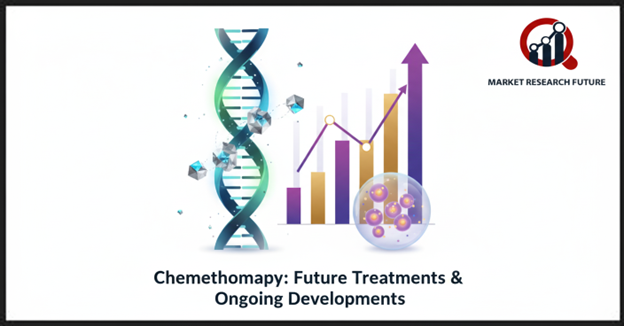Chemotherapy Future Treatments and Ongoing Developments in the Healthcare Industry

Chemotherapy Market Overview
Chemotherapy remains one of the cornerstone treatments in oncology, designed to destroy rapidly dividing cancer cells and prevent their spread. Administered through potent drug formulations, chemotherapy can be used as a primary treatment, adjuvant therapy (after surgery or radiation), or neoadjuvant therapy (before other treatments), depending on the stage and type of cancer. While it has been a mainstay in cancer management for decades, ongoing advancements are reshaping its application — with a shift toward targeted therapies, combination regimens, and precision medicine.
The global chemotherapy market is witnessing steady evolution, driven by the rising global cancer burden, advancements in drug delivery systems, and growing investment in oncology R&D. The introduction of personalized treatment protocols, genomic profiling, and biological adjuncts is transforming chemotherapy from a one-size-fits-all approach into a more effective and patient-centric treatment model.
Current Chemotherapy Approaches
Chemotherapy can be administered through multiple methods, tailored to patient needs and cancer types:
- Systemic Therapy – intravenous or oral drugs circulate throughout the body, targeting metastasized cells.
- Regional Therapy – localized administration to specific organs or areas (e.g., hepatic artery infusion for liver cancer).
- Combination Therapy – chemo used alongside surgery, radiation, or immunotherapy to enhance efficacy.
- High-Dose Therapy with Stem Cell Rescue – used in aggressive cancers, followed by stem cell transplantation to restore bone marrow function.
While effective, these treatments often come with side effects due to damage to healthy cells, including hair loss, fatigue, nausea, and low immunity, which continue to drive research into safer and more targeted alternatives.
Future Directions and Emerging Treatments
The future of chemotherapy is being reshaped by precision oncology and novel drug development, focusing on minimizing toxicity and improving patient outcomes. Key innovations include:
- Targeted Therapies – drugs designed to specifically attack cancer cells based on genetic markers, reducing harm to normal tissues.
- Immunochemotherapy – combination of chemotherapy with immunotherapy to harness the body’s immune system for more durable responses.
- Nanotechnology in Drug Delivery – use of nanoparticles for controlled localized release of chemotherapy agents.
- Chemoprevention – preventive chemotherapy for high-risk individuals with genetic predispositions (e.g., BRCA1/2 mutations).
- DNA Repair Agents – compounds such as NAD precursors that protect healthy cells and repair DNA damage caused by radiation and chemo.
These advancements are paving the way for personalized regimens that align with each patient’s genetic profile, reducing adverse effects and improving treatment precision.
Key Applications
Chemotherapy continues to be integral across a wide spectrum of oncology applications:
- Post-surgical adjuvant therapy to eliminate residual cancer cells
- Neoadjuvant therapy to shrink tumours before surgery or radiation
- Palliative care to relieve symptoms in advanced cancer stages
- Preventive therapy (Chemoprevention) for high-risk patients
- Combination therapies with biologicals, immunotherapies, and targeted drugs
The integration of biomarker-driven treatment and AI-assisted clinical decision-making is enabling oncologists to design customized therapy plans with improved prognostic accuracy.
Market Challenges
Despite its vital role, the chemotherapy market faces several challenges:
- High Toxicity Levels – leading to severe side effects and quality-of-life concerns
- Drug Resistance – tumour adaptation reduces long-term efficacy
- High Cost of Treatment – especially with combination and targeted regimens
- Access Inequality – limited availability in low-income regions
- Sustainability and Supply Chain – complex logistics for drug manufacturing and cold storage
Addressing these challenges will require continued investment in R&D, global healthcare policy alignment, and affordable innovation models.
Regional Analysis
North America leads the global chemotherapy market, supported by a robust oncology infrastructure, strong pharmaceutical R&D pipeline, and favourable reimbursement policies. The U.S. remains the largest market, with ongoing clinical trials in precision oncology and combination therapies.
Europe follows closely, benefitting from advanced healthcare systems, government-backed cancer research programs, and rising adoption of targeted and immuno-chemotherapy regimens. Countries like Germany, the U.K., and France are at the forefront of clinical innovation.
The Asia-Pacific region is witnessing the fastest growth, fuelled by increasing cancer prevalence, expanding healthcare infrastructure, and rising government investments in oncology research. China, India, and Japan are key markets focusing on biosimilars and cost-effective chemotherapy solutions.
Latin America shows gradual expansion, particularly in Brazil and Mexico, with growing access to oncology care despite infrastructure challenges. In the Middle East and Africa, countries such as Saudi Arabia, UAE, and South Africa are investing in cancer centres and advanced treatments, though overall access remains limited compared to developed regions.
Impact of COVID-19
The pandemic disrupted oncology care globally, delaying treatments and clinical trials. However, it also accelerated telemedicine adoption, digital monitoring, and home-based chemotherapy options. The renewed focus on resilient healthcare systems and supply chain optimization is expected to benefit the chemotherapy market post-pandemic.
Conclusion
Chemotherapy continues to serve as a critical pillar in cancer treatment, complemented by rapid advancements in targeted, personalized, and combination therapies. While traditional chemotherapy faces challenges from toxicity and resistance, the future lies in precision oncology, nanotechnology-enabled delivery systems, and DNA repair agents that protect healthy cells.
With ongoing innovations, expanding clinical research, and rising global cancer incidence, the chemotherapy market is poised for significant transformation — moving toward safer, more effective, and patient-centred cancer care solutions.

Leave a Comment